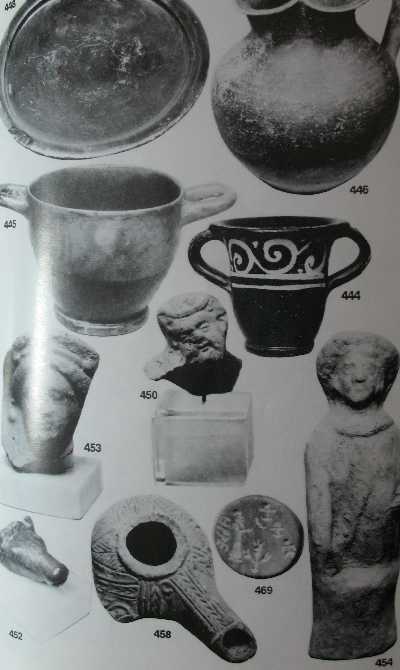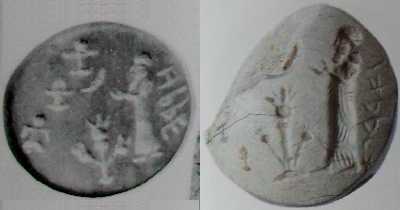On the way out to my car for a snack, I crossed paths with Ms. Cahill again for a few minutes. I told her about the "lame Bet" issue relating to the "Madonna" seal (p. 4 in this series), & also about the terrific/surprising lecture by Carolina Aznar (p. 7).
After the snack, I went back in, & as I passed by the booksellers' room, I noticed Robert Deutsch browsing one of the tables. I managed to corral him into a private area outside where he could autograph some of his publications for me. I told him, too, about Dr. Aznar's amazing discoveries, & showed him some of the drawings I made a few years ago of King Hezekiah's seal designs, that made me inclined to believe there was only 1 "upward-wings" scarab seal. I had tucked these printouts in one of the BAR magazines he signed for me, & had totally forgotten to study my notes in preparation for a discussion such as this. The best I could do was tell him what I believed, & show him the drawings, but I was not prepared to argue the fine points. For those who don't know, he (& everyone else I know) believes there were 2 similar seals, & that you can distinguish them primarily by whether an internal wing/feather-line is dual or single. On another occasion some years ago, Gil Chaya told me that he could easily distinguish the 2 designs by counting these lines.
I began this project in May of 2004 shortly after publishing my first book, & stopped working on it in December of that year. Though I don't want to publish it here (my intention was, & still is, to publish it in a booklet), I don't mind mentioning a few key elements here (blogs are an excellent means by which you can timestamp original ideas for copyright purposes).
Altogether I had photos of 13 different bullae subdivided into 3 groups: HBD-1 thru -4, HBS-1 thru -5, & HC-1 thru -4. "H" stands for "Hezekiah", "B/C" for "beetle" or "circle", & "D/S" for "dual" or "single".
In the booklet, I ask my readers: "Why would an expert lapidary carefully reproduce such tiny details as the inscription letters on these seals without the slightest improvisation, & then completely change a seemingly irrelevant detail such as the feathers? Furthermore, how did he or she manage to do this? The entire width of the seal design is less than a half-inch (about 1 centimeter)!"
After re-reading the rough draft of my booklet just now, I smacked myself in the head for not having remembered for Robert the major reason why there was only 1 seal instead of 2--the seal's icon was cleaned at some point--probably to remove hardened clay & add a little detail to the icon! The inscription & overall outline of the icon are identical on HBD & HBS (that's what I show on my drawings), but the details within the icon are slightly different (the # of lines that Mr. Chaya told me he could count, & the long dual/single middle line as pointed out by Mr. Deutsch in his BAR article).
The color photos I showed Robert Deutsch last week had my drawings of the 2 versions of the 1 seal overlaid on the same bullae proving my theory. It's unfortunate that I was not prepared to give him a convincing presentation--I had packed this magazine (where I've kept the drawings) in my duffel bag along with other publications for VIPs to sign, & never knew they were there till I opened it & said, "Here, sign this! Oh, by the way, here are my drawings of King Hezekiah's seal I worked on a few years ago..."
It's extremely doubtful that anyone attempting to forge a seal for King Hezekiah in the 20th century could have conceived of this rework on the design--they would never have risked such an obvious change. One of the points I was planning to make was that this lends credence to the authenticity of the bullae, but now I'll be able to publish my booklet with even stronger evidence vis-a-vis petrographic analyses.
I regret not having been able to attend Eran Arie & Yuval Goren's lecture on the authenticity of these bullae at the SBL conference (see ANE-2 Message #6379 where he affirmed they were authentic), but I simply couldn't justify spending the whole day for it when I needed to take care of personal matters at home (I only attended 1 day--Thursday--of the ASOR conference, & this one was on Friday). If anyone reading this blog attended, please forward a link to your review of it, or feel free to post your observations in the Comments section. Here's the title & abstract:
"Indelible Impression: The Judahite Correspondence According to Petrographic Analysis of Clay Bullae"
"Judahite papyri were not preserved in the archaeological record and the information contained in them was lost. The bullae, which once sealed these documents, form the only existing evidence of a rich writing tradition that existed during the Iron Age. This paper will present the results of a petrographic study of Judahite bullae from controlled excavations, which can be divided into two main groups. The first comprises some fifty items from Jerusalem, found scattered in a room, which had been destroyed by fire during the Babylonian conquest. The second group is composed of seventeen bullae which were stored in a juglet that was deposited in Stratum II at Tel Lachish. Only few additional bullae were found in recorded excavations in other sites across Judah. Our research focuses on the patterns of the Judahite correspondence during the 7th and early 6th centuries B.C.E. It was aimed at addressing the following questions: a) Can the areas under direct rule from Jerusalem be distinguished by the provenance of the bullae? b) Are certain regions in Judah better represented than others? c) Were all the documents actually sent from the confines of Judah? d) Is there any correlation between private names and the provenance of the bullae? e) Were the bullae stamped with the same name sent from the same place? The identification of the provenance of the bullae shes [sic] light on the administration system of Judah and the political and economic structure of the kingdom of Judah during its final days."
One thing that I was a little more prepared to discuss with Robert Deutsch was my "LADRPA" seal. A near-identical specimen is in his book, "Biblical Period Personal Seals in the Shlomo Moussaieff Collection" (#108 on p. 115; co-authored with Andre Lemaire, whom Deutsch respectfully referred to as "the best").
Here's the interesting part. Their book was published in 2000. I had purchased my version of the seal from Colosseum Coin Exchange, Inc. (a New Jersey mail-bid auction back then) that closed on August 27, 1997 (at 3:00 PM EST if you want to be exact; Auction #96). They're still in business, & have been "since the early sixties" according to their website's Profile page. The proprietors were (are?) Lisa & Ira Teitelbaum, though their names ain't published anywhere on their site, & only their first names are in their catalogs; this always seemed a little suspicious to me.
My seal was lot #469, described as "Tan hardstone seal depicting man standing r.; below pomegranite; [sic] to r. small figure and uncertain objects; to l. script, ca. 1st mil. BC, 23mm--RARE & CHOICE" with a $75 minimum bid, & $250 estimate:

I was the high bidder & purchased it for $133.38 (including the postage, divided among 2 other items I bought from them). Though it's obviously not worth that anymore (their catalog's Terms of Sale allowed only a 90-day window for a dispute, & it would've had to come "from an expert outside of the commercial realm", thereby disqualifying Robert Deutsch, who is an expert inside of said realm), it's still an interesting piece demonstrating that there are people forging seals out there, an operation that's much easier to do than the faking of a LMLK jar handle, which would require building a jar from clay nearly identical with the kind used for the real ones, fashioning it with wheel-turning rings, faking a seal, then stamping & firing the jar, then faking some patina, & finally smashing it & discarding everything but the handles. And one would have to be extremely cautious in carving the seal so that its design matched genuine specimens kept in multiple museums on multiple continents. A rather expensive (& risky) operation when they're apparently available on the surface throughout Israel (according to published excavation surveys). I can say unequivocally that I've never seen any evidence for a fake LMLK handle (though I've heard reports of genuine ones that have been tampered with by the addition of a fake Personal seal).
Upon closer inspection, I can see several telltale signs that someone copied mine from the one in the Moussaieff collection:

- The original one is a positive inscription; mine is a complete negative/mirror image of it (in the side-by-side photo above, I mirrored the image of mine--you can easily see that compared to the earlier photo of the entire catalog page); the forger apparently worked from an impression.
- The inscription on mine was carved by someone who had no idea what he/she was writing, & it looks more like "HRRE" (I suppose they were in a "hurry"!)
- The left & right branches of the pomegranate tree sprout from the base of the vertical branch in the original; on mine, they sprout from the middle.
- The main figure's robe in the original contains many detail lines; mine has only a few vertical strokes in the bottom portion (not visible in the photo due to lighting; again, they apparently didn't spend much time working on it).
- Whereas the original was probably found in the field broken like this in ancient times, the break intersected what was probably a crescent moon spanning a large portion of the missing region; in mine, the forger faithfully copied the visible portion of the crescent, but improvised 3 strange-looking figures in the missing region.
I had not noticed any of these clues until this meeting with Robert Deutsch, & then scrutinizing it further tonight. We originally corresponded by E-mail about it in March of 2000 coincidentally while his book was still at the printer. I had hoped that maybe by showing it to him in person (I had only provided a photo in 2000) that he might see something that would cause him to change his mind in favor of its authenticity; instead, I saw something new that changed my mind in favor of its fakeness.
I thanked him. He went back to the booksellers, & I moved on to the next lecture...
G.M. Grena

No comments:
Post a Comment